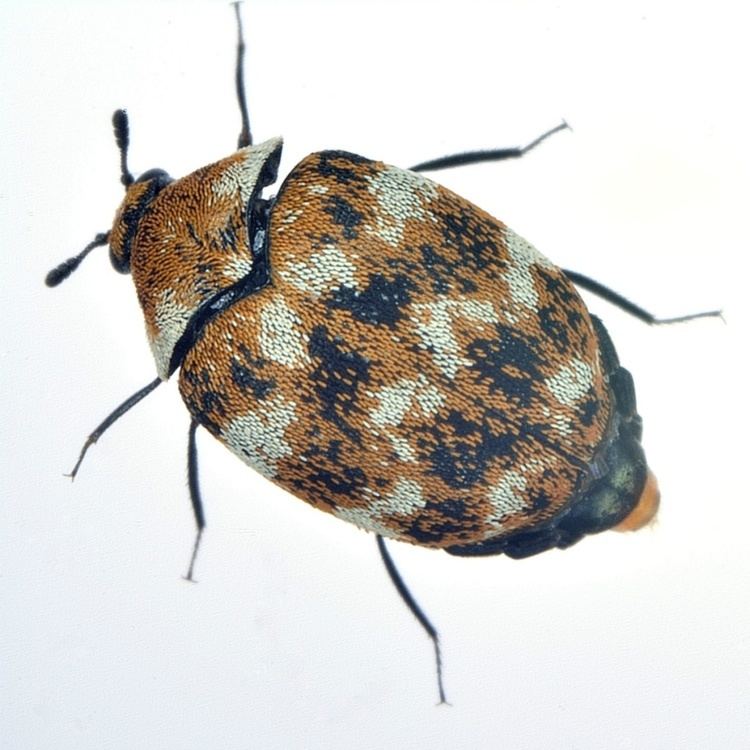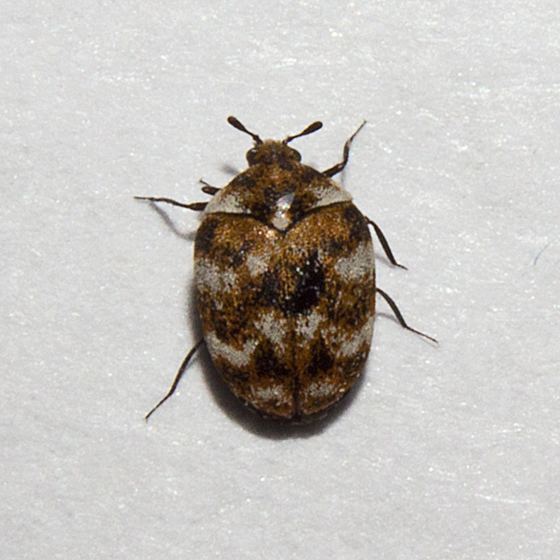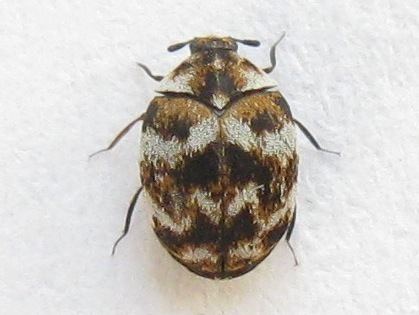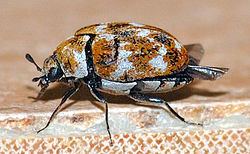Order Coleoptera Higher classification Anthrenus | Scientific name Anthrenus verbasci Rank Species | |
 | ||
Similar Beetle, Dermestidae, Insect, Anthrenus, Black carpet be | ||
The varied carpet beetle (Anthrenus verbasci) is a 3 mm-long beetle belonging to the family Dermestidae.
Contents
This beetle in larval form is common in houses where it usually does little or no noticeable harm, but it is a feared pest in natural history museums, where it can seriously damage biological specimens. While adults are pollen grazers, larvae feed on natural fibers and can damage carpets, furniture, clothing and insect collections. As the beetles are extremely common in gardens in the summer it is impossible to eradicate them completely from a normal home. Regular vacuuming will keep their numbers down.

The larval form is known as a woolly bear, a name it shares with the larvae of Arctia caja and many other moths of the family Arctiidae.

A. verbasci was the first insect to be shown to have an annual circadian rhythm and to date remains a classic example of circannual cycles in animals.

Identification

Adult A. verbasci range from 1.7 to 3.5 mm (0.07 to 0.14 in) in length. The body is rounded, almost spherical. Elytra and pronotum have an irregular pattern of white, brownish and yellowish patches formed by scales of different colours. Whitish scales are condensed along the lateral margins of the pronotum and on the elytra, where they form three bright, wavy transversal bands. In addition, their antennae are 11-segmented with a club of 3 segments.
The larval form of A. verbasci are roughly 4–5 millimetres (0.16–0.20 in) in length. The larvae are elongate and densely hairy. The body is covered in a pattern of alternating light and dark-brown stripes. The body is usually wider at the back than at the front and also bears 3 pairs of hair tufts along its rear abdomen that can be used for self-defense.
Distribution
This species is present in most of Europe, in the eastern Palearctic ecozone, in the Near East, in the Nearctic ecozone, in the North Africa and in North Asia.
Life cycle
A. verbasci has an unusual life cycle for an insect, developing from larvae to adult in 1–3 years, depending on the environmental conditions. Larvae hatch from eggs in the spring and early summer, often in the nests of birds (including those of the house sparrow and house swift) or around stored fabrics.
Larvae feed on keratin and chitin of natural fibers (dead insects, animal hair and feathers) throughout their development, eventually experiencing a dormancy period (also known as diapause) prior to pupation into the adult stage. The length of the dormancy appears to depend on environmental factors, with the most likely zeitgeber being photoperiod.
Adults emerge between late May and early August, flying to and feeding on the pollen and nectar of flowering plants. The life expectancy of the beetle is about two weeks. During this period, mating occurs and the eggs are laid, either close to the human environs or in bird nests, tree hollows and similar, dry places where larvae can find their food. Then the cycle begins anew.
Predators
Among the natural predators of A. verbasci, one of the most well-studied is the parasitoid wasp Laelius pedatus. Upon discovering an A. verbasci larva, a female wasp will land on the larva's dorsal side and attempt to line up its long, stinger-like ovipositor for a paralyzing blow to the thorax. In response, the larva will erect long hairs on their abdomen and attempt to brush these hairs against the encroaching wasp. The hairs detach and stick to the wasp on contact, presumably causing some sort of irritation. Evidently, such irritation is not enough to deter an attack on A. verbasci larvae, as the vast majority of attacks are successful. Such a defense, however, has been shown to be effective for the closely related species Anthrenus flavipes, which has slightly longer hairs than A. verbasci.
After a single successful sting, the beetle is permanently paralyzed. The entire process from landing to complete paralysis lasts approximately 40 seconds. L. pedatus does not lay eggs immediately after the beetle is paralyzed, waiting as long as 24 hours before oviposition. During this time, she grooms herself, removing any hairs that might have stuck to her during the attack. During this lengthy process she appears to monitor the larva’s state of paralysis by repeatedly biting it and monitoring its reaction. Once sufficiently clear of hairs, the wasp creates a bare patch on the larva’s abdomen and lays 2–4 eggs. Eggs hatch in 3–4 days and the larvae feed on the beetle for 3–7 days, eventually killing the host. They then spin cocoons near the empty shell of the host, emerging some time later as adult wasps.
Interaction with humans
The larvae of A. verbasci are a common household pest. Adult beetles usually lay their eggs in air ducts, in closets, under furniture, or under baseboards. Once hatched and until they pupate into adults, the larvae hide in dark, undisturbed areas and feed on organic material. The larvae are thus responsible for the damage of various items, such as furniture, clothing, blankets, furs, and carpets. They are commonly found in musical instruments which have been stored for lengthy periods of time, feeding on pads and felts most commonly found in woodwind instruments. Collections of specimens, especially of insects, are also vulnerable to attack, making A. verbasci a common pest in museums. Infestations can be prevented by regular vacuum cleaning, dry cleaning or airing clothing outside, placing naphthalene balls in closets, and removing abandoned bird and insect nests attached to the building. Signs of an infestation include the presence of damaged articles, molted larval skins in dark areas, and an abundance of adult beetles near windows. Susceptible people may also find that shed hairs from the larvae cause irritated itchy welts that may be confused with bedbug bites. Deterring or killing A. verbasci can be accomplished using insecticides, oxygen deprivation, freezing, and pheromone and scent traps.
